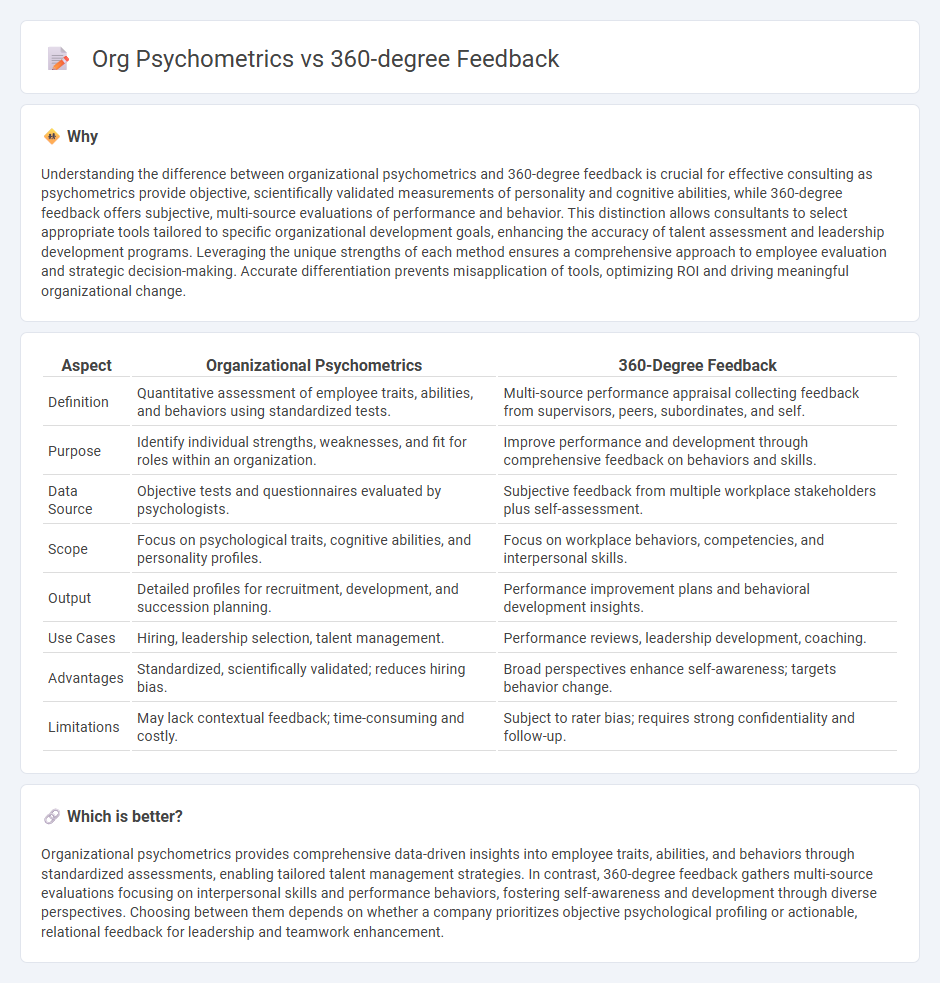
Organizational psychometrics involves scientifically measuring employees' psychological attributes to enhance workplace performance and culture. In contrast, 360-degree feedback collects comprehensive evaluations from peers, subordinates, and supervisors for holistic performance appraisal. Explore how these tools can transform talent management strategies effectively.
Why it is important
Understanding the difference between organizational psychometrics and 360-degree feedback is crucial for effective consulting as psychometrics provide objective, scientifically validated measurements of personality and cognitive abilities, while 360-degree feedback offers subjective, multi-source evaluations of performance and behavior. This distinction allows consultants to select appropriate tools tailored to specific organizational development goals, enhancing the accuracy of talent assessment and leadership development programs. Leveraging the unique strengths of each method ensures a comprehensive approach to employee evaluation and strategic decision-making. Accurate differentiation prevents misapplication of tools, optimizing ROI and driving meaningful organizational change.
Comparison Table
| Aspect | Organizational Psychometrics | 360-Degree Feedback |
|---|---|---|
| Definition | Quantitative assessment of employee traits, abilities, and behaviors using standardized tests. | Multi-source performance appraisal collecting feedback from supervisors, peers, subordinates, and self. |
| Purpose | Identify individual strengths, weaknesses, and fit for roles within an organization. | Improve performance and development through comprehensive feedback on behaviors and skills. |
| Data Source | Objective tests and questionnaires evaluated by psychologists. | Subjective feedback from multiple workplace stakeholders plus self-assessment. |
| Scope | Focus on psychological traits, cognitive abilities, and personality profiles. | Focus on workplace behaviors, competencies, and interpersonal skills. |
| Output | Detailed profiles for recruitment, development, and succession planning. | Performance improvement plans and behavioral development insights. |
| Use Cases | Hiring, leadership selection, talent management. | Performance reviews, leadership development, coaching. |
| Advantages | Standardized, scientifically validated; reduces hiring bias. | Broad perspectives enhance self-awareness; targets behavior change. |
| Limitations | May lack contextual feedback; time-consuming and costly. | Subject to rater bias; requires strong confidentiality and follow-up. |
Which is better?
Organizational psychometrics provides comprehensive data-driven insights into employee traits, abilities, and behaviors through standardized assessments, enabling tailored talent management strategies. In contrast, 360-degree feedback gathers multi-source evaluations focusing on interpersonal skills and performance behaviors, fostering self-awareness and development through diverse perspectives. Choosing between them depends on whether a company prioritizes objective psychological profiling or actionable, relational feedback for leadership and teamwork enhancement.
Connection
Organizational psychometrics provides the scientific measurement tools that underpin 360-degree feedback by assessing employee competencies, behaviors, and performance patterns from multiple perspectives. 360-degree feedback leverages psychometric assessments to deliver comprehensive evaluations involving self, peer, subordinate, and supervisor ratings, ensuring data reliability and validity. This integration enhances leadership development, talent management, and organizational effectiveness by offering actionable insights rooted in robust psychometric analysis.
Key Terms
Multisource Assessment
Multisource assessment integrates 360-degree feedback and organizational psychometrics to evaluate employee performance and behavioral competencies comprehensively. While 360-degree feedback collects subjective ratings from peers, leaders, and subordinates, org psychometrics employs scientifically validated tests to measure traits, motivations, and cognitive abilities. Explore the strengths of both approaches to optimize talent development and organizational effectiveness.
Behavioral Metrics
360-degree feedback captures comprehensive behavioral insights through multi-source evaluations, reflecting how employees' actions align with organizational values. Organizational psychometrics employs standardized assessments to measure underlying personality traits and cognitive abilities driving behavior. Explore the nuanced differences to enhance talent management strategies effectively.
Psychometric Evaluation
360-degree feedback gathers multi-source assessments from peers, supervisors, and subordinates to provide a comprehensive view of an employee's performance and behaviors. Organizational psychometrics utilizes scientifically validated tools and tests to measure cognitive abilities, personality traits, and emotional intelligence, ensuring precise psychometric evaluation. Explore how integrating both approaches can enhance talent management and leadership development strategies.
Source and External Links
What is 360 Degree Feedback? - CustomInsight - 360 Degree Feedback is an assessment process where employees receive confidential, anonymous evaluations from managers, peers, and direct reports to gain a comprehensive view of performance and promote self-awareness and development.
360 Degree Feedback: Process, Examples & Template - Personio - It involves collecting feedback from multiple stakeholders like managers, peers, and direct reports to provide a holistic and well-rounded evaluation of employee performance beyond just a manager's review.
360 Degree Feedback: A Comprehensive Guide - AIHR - This method gathers input from various internal and sometimes external sources, combining ratings and comments to offer balanced perspectives that help employees understand their strengths and areas for improvement.
 dowidth.com
dowidth.com